|
|
|
|
17:04:11 23rd April 2024ce — 13 new posts in the last 24 hours
|
Creag Nan Uamh
Inside Scotland's ancient Bone Caves
Posted by drewbhoy, 17.04.24
Stonehenge
Stonehenge research explores possible Moon connection
Posted by drewbhoy, 16.04.24
Arthur's Stone
Arthur's Stone featured on one of four new murals in Hereford
Posted by MelMel, 16.04.24
Scotland
Modernising the hunt for Scotland's buried treasure
Posted by drewbhoy, 15.04.24
Perth and Kinross
Crannog Centre rises from the ashes three years after fire
Posted by drewbhoy, 02.04.24
Must Farm Logboats
Bronze Age 'recycling bin' found at quarry site
Posted by drewbhoy, 30.03.24
|
|
Pleasant Valleys Sunday - Between Sirhwyi and Rhymni 30 January 2022
Posted by thesweetcheat, 15.01.23
Cerrig Duon and the Tawe valley Triangle
Posted by cerrig, 24.10.21
Television made me do it.
Posted by postman, 22.06.21
Dude wheres my car?
Posted by postman, 28.09.20
Days without end.
Posted by postman, 05.07.20
|
Henge found in Lincolnshire
Posted by spencer, 21.04.2024
Rock Art
Posted by spencer, 17.04.2024
Stonehenge, long ago
Posted by spencer, 05.04.2024
Use of Photos
Posted by drewbhoy, 27.03.2024
Nigel Swift, RIP
Posted by ocifant, 04.03.2024
|
Slievecorragh
Re: Image by ryaner
Comment by ryaner, 19/04/2024
Aran Fawddwy
Re: Image by thesweetcheat
Comment by thesweetcheat, 17/04/2024
Cat Cairn 2
Re: Image by LesHamilton
Comment by drewbhoy, 17/04/2024
Aran Fawddwy
Re: Image by thesweetcheat
Comment by drewbhoy, 17/04/2024
Arthur's Stone
Re: Image by MelMel
Comment by thesweetcheat, 16/04/2024
|
|
Cat Cairn 2
Posted by LesHamilton, 17.04.24
Kilmory Knap Chapel
Posted by drewbhoy, 14.04.24
Blackfaulds Stone Circle
Posted by drewbhoy, 20.03.24
Williamston
Posted by drewbhoy, 20.03.24
Ardgilzean Cottage
Posted by drewbhoy, 19.03.24
|
The Whipping Stone
Posted by Zeb, 31.03.24
Loch Pityoulish
Posted by drewbhoy, 30.03.24
Dun Ghallain
Posted by drewbhoy, 25.03.24
Giants' Graves
Posted by drewbhoy, 25.03.24
Kildalloig
Posted by drewbhoy, 21.03.24
|
Moel Faban Settlement
Moel Faban Settlement
Posted by GLADMAN, 13.03.24
King's Wood
King's Wood 'Mound'...
Posted by GLADMAN, 13.03.24
|
  The Modern Antiquarian by Julian Cope is published by Thorsons. In October 2004ce Julian Cope published The Megalithic European, a landmark guide to the stones of ancient Europe. |






















Latest Comments